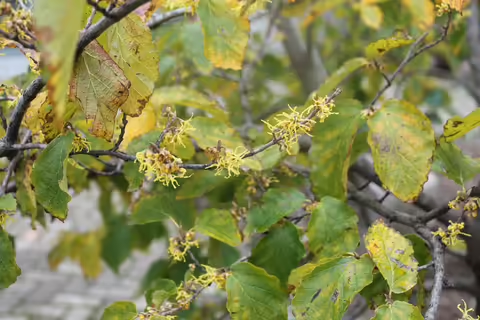URBANA, Ill. – With a name befitting the season it blooms, common witch hazel is a fall favorite for Illinois gardeners looking to add a small tree with character to their yard.
“People are very interested in plants that add some interest to their landscape in fall and winter,” says Gemini Bhalsod, University of Illinois Extension horticulture educator. “Common witch hazel is one of my favorites because it supports pollinators and has unusual yellow flowers.”
There are many different witch hazels, all in the Hamamelidaceae plant family. Common witch hazel, or Hamamelis virginiana, is native, although it is uncommon in natural areas as Illinois is the western edge of its native range.
“Witch hazel is a beautiful addition to any garden because of its linear yellow flowers,” Bhalsod says. “The long, thin petals give the small flowers an interesting texture that stands out in the fall.”
Since common witch hazel blooms late in the year, its flowers blend in nicely with the colorful turning of the leaves. In Northern and Central Illinois, it flowers around mid-October, and in Southern Illinois, near the end of October.
Witch hazel is susceptible to few pests and diseases making it a great low-maintenance addition to any landscape. It even supports wasps, flies, and various moths.
“You might not think of flies or small wasps when you think of pollinators, but just like bees and butterflies, they are important to our ecosystem,” Bhalsod says. “Witch hazel also provides crucial cover for birds, who also eat its seeds.”
Take an inventory of the conditions in your yard before planting a witch hazel tree in early spring. Witch hazel is also sometimes called a large shrub because it might have one trunk or multiple trunks, but it can grow to be about 20 feet tall. It provides enough screening for edges and borders, but also works well as an understory tree.
It blooms the best when planted in part-sun, but it is adapted to many different growing conditions and is relatively shade tolerant. It works well in sandy to loamy soils with good drainage.
Illinois Extension has more information about witch hazel.
SOURCE: Gemini Bhalsod, Horticulture Educator, Illinois Extension
ABOUT EXTENSION: Illinois Extension leads public outreach for University of Illinois by translating research into action plans that allow Illinois families, businesses, and community leaders to solve problems, make informed decisions, and adapt to changes and opportunities.
PHOTO ACCESS: The photo in this article is available for media use.
